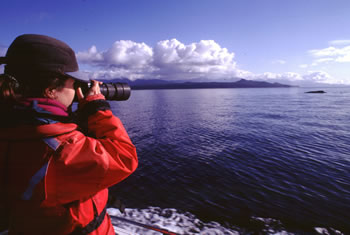 by Doug Schneider August 08, 2003
Janet Doherty has a life many people would envy. As a biological technician with the National Park Service, she spends her days in a small open boat in Alaska's Glacier Bay National Park. There she keeps watch on humpback whales as they swim, feed and sometimes leap into the air. With at least 60 whales identified in the park this summer, Doherty says the whale watching has been especially good. Doherty said, "We've had what we think is probably going to be a record number of whales in Glacier Bay. Every time we go out it just seems like we're surrounded by blows and animals. It's really neat." Humpback whales come to Glacier Bay's deep, icy-cold waters to feed on schools of small fish. Species like juvenile pollock, herring, sand lance and capelin are the humpback's favorite catch of the day. Doherty says there's a lot of whales in the park because there's a lot of food for them eat. "It seems like we've got a pulse going on the past few weeks. A lot of the whales that we see spread out over the summer are all here at once. It probably has something to do with the fact that there are a lot of fish here right now and they are drawn to this area because of that," said Doherty. But it's not just whales that come to Glacier Bay. Dozens of cruise ships bring tens of thousands of tourists each summer to see the park's majestic tidewater glaciers, pristine fjords, and of course humpback whales. Between the whales, the cruise ships and other vessels in the park, the place can get pretty crowded. It's Janet Doherty's job to make sure the whales have plenty of room. Doherty said, "What I'm doing for the Park Service is monitoring the whale population, who's around, how many are there, where are they? The way we do that is we go up to the whale and take a location, latitude and longitude off a GPS, and then we also take photographs to identify it as an individual." Occasionally, when there are too many whales and vessels in close proximity, park officials impose course and speed restrictions on vessels to minimize their disturbance to feeding whales. When she's not keeping watch on Glacier Bay's whales, Janet Doherty is a graduate student at the University of Alaska Fairbanks School of Fisheries and Ocean Sciences. As a budding scientist, she's doing another important job in Glacier Bay. That job is to study humpback Doherty said, "What I'm doing for my master's degree up there at UAF is looking at humpback whale entanglement in fishing gear. I'm trying to assess how frequently that's happening by looking at scarring patterns on the bodies of humpback whales, mostly around the tail stock, where the tail joins the body. That's a narrow area, a bottleneck, where when they do get wrapped up in gear, the gear gets wrapped around that part of the body. And when the gear is freed it usually leaves injuries, and those injuries scar up. Those scars are distinct and last for many years. They don't look natural. They look like binding marks and wrap marks. So if you take photos of that part of the body you can determine what portion of the population has had interactions with fishing gear. So I'm trying to get some baseline data on how much of an issue that is in Southeast Alaska." Doherty's university study extends beyond the park boundaries to include nearby Icy Strait and waters as far south as Sitka and Petersburg, about 125 miles away. Doherty says that about ten reports come in each year of humpback whales caught in fishing gear, with most of those reports coming from Southeast Alaska. But since the region is so vast and remote, Doherty says the number of entangled whales is probably higher. In other parts of the country, such as the Gulf of Maine, for example, scientists there found that about half the humpback whales appeared to have scars left by fishing gear. Doherty says most whales eventually free themselves from the fishing gear, but not before the lines leave gashes in their hide. Come October and November, Glacier Bay's humpback whales will begin migrating south to calving grounds off Hawaii. Janet Doherty will resume her study next summer, when the whales return. She says she'll then be on the lookout for whales arriving back in Alaska sporting fresh signs of having been entangled in fishing gear.
Story & photos courtesy of:
|
|||
